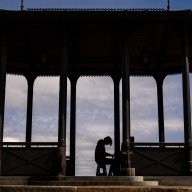There was a time when I had beautiful handwriting, a lovely cursive script with distinctive jaunty flourishes with the uppercase “A” and the lowercase “g” and “j.” But no more.
Keyboards — first an IBM Selectric and then a computer — completely destroyed my ability to write in longhand.
Today, I’d have better luck reading ancient Sumerian runic symbols than anything I might have written down in the last 10 minutes. The only way I can be remotely legible is to jot down everything in ALL CAPS.
This is kind of what happened to album artwork. In the old days, LPs offered a 12-by-12 pallet (double that if you include the back) that could be a source of mystic, wonder and legend: the man with the sticks on Led Zeppelin IV; Paul McCartney barefoot and out of step on Abbey Road; the swimming baby of Nevermind. Who knows how many albums were sold on the strength of a Roger Dean painting or a surreal Hipignosis landscape? And how many careers were launched as a result of the amazing packaging created by Factory Records?
Album artwork was mortally wounded by the CD and rendered almost irrelevant by the MP3. Yet there are still those who believe in its power — like Eminem.
Frankly, I’m not the biggest Eminem fan, but I did buy his new record, Recovery, partly because of the album’s alternate cover. The image, created by British photographer Nigel Parry, is set in Hart Plaza in Detroit next to the Renaissance Center, the headquaters of General Motors. The place is deserted, save for Eminem in his hermetically sealed Perspex box with his couch, flat screen TV and some reading material.
There are several layers and multiple interpretations within this shot. There’s Em’s stints in rehab — prompted by an accidentally overdose of methadone — where he recovered from addictions to Vicodin, Valium and Ambien. But because he’s in a box, what does that say about his state of mind and self-perception?
There’s Detroit and the auto industry’s wished-for recovery and, dare we say it, renaissance after decades of decline. But why is the plaza deserted?
Before you hear a single note or rhyme, Recovery is mysterious, disturbing and thought-provoking — all thanks to the artwork. And isn’t that great to see for a change?
















